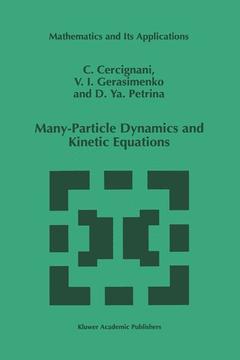Many-Particle Dynamics and Kinetic Equations, Softcover reprint of the original 1st ed. 1997 Mathematics and Its Applications Series, Vol. 420
Langue : Anglais
Auteurs : Cercignani C., Gerasimenko U.I., Petrina D.Y.

As our title suggests, there are two aspects in the subject of this book. The first is the mathematical investigation of the dynamics of infinite systems of in teracting particles and the description of the time evolution of their states. The second is the rigorous derivation of kinetic equations starting from the results of the aforementioned investigation. As is well known, statistical mechanics started in the last century with some papers written by Maxwell and Boltzmann. Although some of their statements seemed statistically obvious, we must prove that they do not contradict what me chanics predicts. In some cases, in particular for equilibrium states, it turns out that mechanics easily provides the required justification. However things are not so easy, if we take a step forward and consider a gas is not in equilibrium, as is, e.g., the case for air around a flying vehicle. Questions of this kind have been asked since the dawn of the kinetic theory of gases, especially when certain results appeared to lead to paradoxical conclu sions. Today this matter is rather well understood and a rigorous kinetic theory is emerging. The importance of these developments stems not only from the need of providing a careful foundation of such a basic physical theory, but also to exhibit a prototype of a mathematical construct central to the theory of non-equilibrium phenomena of macroscopic size.
I: The Bbgky Hierarchy.- 1.1. Introduction.- 1.2. The Hamilton dynamics of a system of particles with hard core.- 1.3. The evolution operator for a system with finite number of particles.- 1.4. The derivation of the BBGKY hierarchy.- 1.5. The steady BBGKY hierarchy.- Appendix I. The infinitesimal operator of the groupSN (t).- Appendix II. The formal derivation of the infinitesimal operator [BB] of the group SN(t).- II: The Initial Value Problem For The Bbgky Hierarchy of a System of a Finite Number of Particles.- 2.1. Introduction.- 2.2. The evolution operator of the BBGKY hierarchy.- 2.4. Existence of solutions for a one-dimensional BBGKY hierarchy.- 2.5. The iteration series.- III: The Initial Value Problem For L? Data: Thermodynamic Limit.- 3.1. Introduction.- 3.2. A local existence theorem for the BBGKY hierarchy of hard spheres.- 3.3. Global existence theorems.- 3.4. Method of the interaction region.- IV: The Derivation of The Boltzmann Equation.- 4.1. Introduction: On the Boltzman-Grad limit.- 4.2. The Boltzmann-Grad limit for equilibrium states.- 4.3. The Boltzmann hierarchy and the Boltzmann equation.- 4.4. The Boltzmann-Grad limit for solutions of initial value problem for the BBGKY hierarchy.- 4.5. The Boltzmann-Grad limit for equilibrium states of systems of hard spheres in the framework of the canonical ensemble.- V: On the Derivation of Kinetic Equations From the Bbgky Hierarchy.- 5.1. Introduction: kinetic equations.- 5.2. Bogolubov’s method of constructing kinetic equations.- 5.3. The non-equilibrium cluster expansions method.- 5.4. Justification of the generalized kinetic equation.- References.
This book is devoted to the evolution of infinite systems interacting via a short range potential. The Hamilton dynamics is defined through its evolution semigroup and the corresponding Bogolubov--Born--Green--Kirkwood--Yvo n (BBGKY) hierarchy is constructed. The existence of global in time solutions of the BBGKY hierarchy for hard spheres interacting via a short range potential is proved in the Boltzmann--Grad limit and by Bogolubov's and Cohen's methods. Audience: This volume will be of interest to graduate students and researchers whose work involves mathematical and theoretical physics, functional analysis and probability theory.
Date de parution : 10-2012
Ouvrage de 247 p.
16x24 cm
Thèmes de Many-Particle Dynamics and Kinetic Equations :
Mots-clés :
Potential; Probability theory; Rang; Theoretical physics; dynamics; functional analysis
© 2024 LAVOISIER S.A.S.
